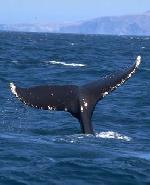Humpback Whale
Home Page
Challenge Questions

Today's News

Spring's Journey North

Report Your Sightings

Search Journey North
return to:

 A/CPB
A/CPB
Humpback Whale Migration Update: April 1, 1998
Today's Report Includes
- Still Time to Name a Humpback Whale!
- Whalewatching Starts in Massachusetts
- Whales Leaving Dominican Republic Waters
- Fewer Humpbacks in Hawaii
- Discussion of Challenge Question #5
- Challenge Question #6
To: Journey North
From: Anne Smrcina
Greetings from the Stellwagen Bank National Marine Sanctuary.
Still Time to Name a Humpback Whale!
Attention whale enthusiasts: You still have time to name one of the new humpback whales that have been listed in
the North Atlantic Humpback Whale catalog (all they have now are numbers). I will be representing JN students
at the official whale naming party now scheduled for April 11th (it was postponed due to one of our few snow storms
this season). Check out my earlier report for the correct procedure to name a whale. Remember -- I need the whale's
catalog number and your written justification in order to defend your suggestion at the meeting.
 |
|
Migration Route of Atlantic Humpback Whales |
It looks like another whalewatching season is upon us. Commercial fleets are restocking their vessels and gearing up for what they hope will be another exciting year of watching humpbacks and other whale species on Stellwagen Bank. Many of the companies will start mid-April, although occasional trips are now being scheduled for the first two weeks of the month. Although the migrating humpbacks have not yet arrived, early whalewatchers may get an opportunity to see right whales (from a distance -- there is a 500 yard
no-approach requirement) and finbacks (several large individuals have been spotted).
Whales Leaving Dominican Republic Waters
 Kim Beddall in the Dominican Republic reports that some humpback
mothers and calves are still in Samana Bay, but most of the other whales seem to have left those sheltered waters
in the Caribbean. Whalewatching there continued well into March. Often the problem was lack of passengers, not
one of lack of whales or boats (many tourists did not know that whales were still being seen past the official
end of the season). Kim mentioned that a large surface active group seen late in March included several large
whales. She has also seen some very tiny babies, probably whales that were just recently born (rather late in
the season). The mothers are probably biding their time until their calves are strong enough to make the long
swim north to the feeding
Kim Beddall in the Dominican Republic reports that some humpback
mothers and calves are still in Samana Bay, but most of the other whales seem to have left those sheltered waters
in the Caribbean. Whalewatching there continued well into March. Often the problem was lack of passengers, not
one of lack of whales or boats (many tourists did not know that whales were still being seen past the official
end of the season). Kim mentioned that a large surface active group seen late in March included several large
whales. She has also seen some very tiny babies, probably whales that were just recently born (rather late in
the season). The mothers are probably biding their time until their calves are strong enough to make the long
swim north to the feeding
grounds.
Fewer Humpbacks in Hawaii
I checked in with the Hawaiian Islands Humpback Whale National Marine Sanctuary to find out how the whale population was doing there, and was told that the numbers are now down. There have been no sightings of whales from
shore, although some whalewatching boats have seen humpbacks in the channels between the islands. Breaching behavior is not being seen, suggesting that the older, competitive groups have already departed, leaving the late mothers to nurse their calves.
Discussion of Challenge Question #5
 Where have the Hawaiian humpbacks gone? My Challenge Question
of last week was about the Hawaiian humpbacks. Where do they go to feed in the summer? It is believed that the
bulk of the Hawaiian humpbacks feed in areas along southwest Alaska, including Glacier Bay National Park. These
whales have a long distance migration with no shallow areas between the islands and the continental shelf off Alaska.
It's still a mystery how the whales find their way between these two distant points.
Where have the Hawaiian humpbacks gone? My Challenge Question
of last week was about the Hawaiian humpbacks. Where do they go to feed in the summer? It is believed that the
bulk of the Hawaiian humpbacks feed in areas along southwest Alaska, including Glacier Bay National Park. These
whales have a long distance migration with no shallow areas between the islands and the continental shelf off Alaska.
It's still a mystery how the whales find their way between these two distant points.
I've mentioned humpbacks in the North Atlantic and in the North Pacific. This week's Challenge Question to you
is:
Challenge Question #6
"Are the North Atlantic and North Pacific the only places to see humpbacks, or are they found elsewhere on
the earth?"
(To respond to this question, please follow
the instructions at the end of this report.)
 That's all until my next report. We should have some 97 new
humpback whale names at that time -- hopefully some from JN students.
That's all until my next report. We should have some 97 new
humpback whale names at that time -- hopefully some from JN students.
This is Anne Smrcina signing off.
How to Respond to Journey North Challenge Question #6
1. Address an e-mail message to: jn-challenge-hwhale@learner.org
2. In the Subject Line of your message write: Challenge Question # 6
3. In the body of your message, answer the question above.
The Next Humpback Whale Migration Update will Be Posted on April 15, 1998.


